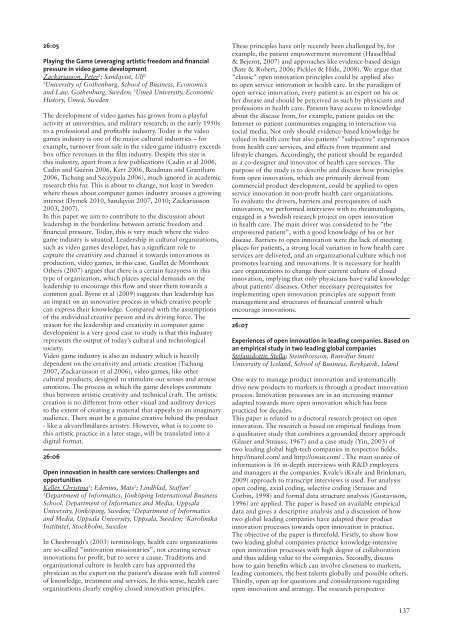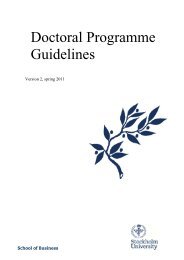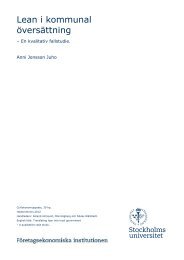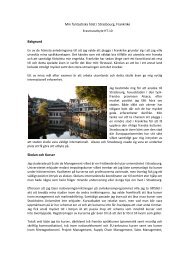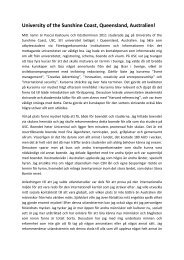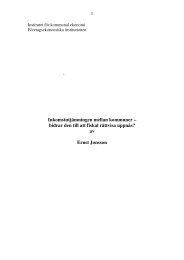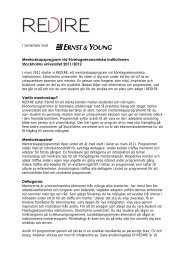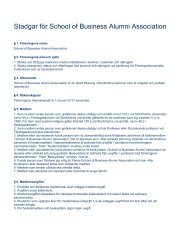Download full programme and abstract book pdf 1.6
Download full programme and abstract book pdf 1.6
Download full programme and abstract book pdf 1.6
Create successful ePaper yourself
Turn your PDF publications into a flip-book with our unique Google optimized e-Paper software.
26:05<br />
Playing the Game Leveraging artistic freedom <strong>and</strong> financial<br />
pressure in video game development<br />
Zackariasson, Peter 1 ; S<strong>and</strong>qvist, Ulf 2<br />
1 University of Gothenburg, School of Business, Economics<br />
<strong>and</strong> Law, Gothenburg, Sweden; 2 Umeå University, Economic<br />
History, Umeå, Sweden<br />
The development of video games has grown from a playful<br />
activity at universities, <strong>and</strong> military research, in the early 1950s<br />
to a professional <strong>and</strong> profitable industry. Today is the video<br />
games industry is one of the major cultural industries – for<br />
example, turnover from sale in the video game industry exceeds<br />
box office revenues in the film industry. Despite this size is<br />
this industry, apart from a few publications (Cadin et al 2006,<br />
Cadin <strong>and</strong> Guérin 2006, Kerr 2006, Readman <strong>and</strong> Grantham<br />
2006, Tschang <strong>and</strong> Szczypula 2006), much ignored in academic<br />
research this far. This is about to change, not least in Sweden<br />
where theses about computer games industry arouses a growing<br />
interest (Dymek 2010, S<strong>and</strong>qvist 2007, 2010; Zackariasson<br />
2003, 2007).<br />
In this paper we aim to contribute to the discussion about<br />
leadership in the borderline between artistic freedom <strong>and</strong><br />
financial pressure. Today, this is very much where the video<br />
game industry is situated. Leadership in cultural organizations,<br />
such as video games developer, has a significant role to<br />
capture the creativity <strong>and</strong> channel it towards innovations in<br />
production, video games, in this case. Guillet de Monthoux<br />
Others (2007) argues that there is a certain fuzzyness in this<br />
type of organization, which places special dem<strong>and</strong>s on the<br />
leadership to encourage this flow <strong>and</strong> steer them towards a<br />
common goal. Byrne et al (2009) suggests that leadership has<br />
an impact on an innovative process in which creative people<br />
can express their knowledge. Compared with the assumptions<br />
of the individual creative person <strong>and</strong> its driving force. The<br />
reason for the leadership <strong>and</strong> creativity in computer game<br />
development is a very good case to study is that this industry<br />
represents the output of today’s cultural <strong>and</strong> technological<br />
society.<br />
Video game industry is also an industry which is heavily<br />
dependent on the creativity <strong>and</strong> artistic creation (Tschang<br />
2007, Zackariasson et al 2006), video games, like other<br />
cultural products, designed to stimulate our senses <strong>and</strong> arouse<br />
emotions. The process in which the game develops commute<br />
thus between artistic creativity <strong>and</strong> technical craft. The artistic<br />
creation is no different from other visual <strong>and</strong> auditory devices<br />
to the extent of creating a material that appeals to an imaginary<br />
audience. There must be a genuine creative behind the product<br />
- like a akvarellmålares artistry. However, what is to come to<br />
this artistic practice in a later stage, will be translated into a<br />
digital format.<br />
26:06<br />
Open innovation in health care services: Challenges <strong>and</strong><br />
opportunities<br />
Keller, Christina 1 ; Edenius, Mats 2 ; Lindblad, Staffan 3<br />
1 Department of Informatics, Jönköping International Business<br />
School, Department of Informatics <strong>and</strong> Media, Uppsala<br />
University, Jönköping, Sweden; 2 Department of Informatics<br />
<strong>and</strong> Media, Uppsala University, Uppsala, Sweden; 3 Karolinska<br />
Institutet, Stockholm, Sweden<br />
In Chesbrough’s (2003) terminology, health care organizations<br />
are so-called ”innovation missionaries”, not creating service<br />
innovations for profit, but to serve a cause. Traditions <strong>and</strong><br />
organizational culture in health care has appointed the<br />
physician as the expert on the patient’s disease with <strong>full</strong> control<br />
of knowledge, treatment <strong>and</strong> services. In this sense, health care<br />
organizations clearly employ closed innovation principles.<br />
These principles have only recently been challenged by, for<br />
example, the patient empowerment movement (Hasselblad<br />
& Bejerot, 2007) <strong>and</strong> approaches like evidence-based design<br />
(Bate & Robert, 2006; Pickles & Hide, 2008). We argue that<br />
”classic” open innovation principles could be applied also<br />
to open service innovation in health care. In the paradigm of<br />
open service innovation, every patient is an expert on his or<br />
her disease <strong>and</strong> should be perceived as such by physicians <strong>and</strong><br />
professions in health care. Patients have access to knowledge<br />
about the disease from, for example, patient guides on the<br />
Internet or patient communities engaging in interaction via<br />
social media. Not only should evidence-based knowledge be<br />
valued in health care but also patients’ ”subjective” experiences<br />
from health care services, <strong>and</strong> effects from treatment <strong>and</strong><br />
lifestyle changes. Accordingly, the patient should be regarded<br />
as a co-designer <strong>and</strong> innovator of health care services. The<br />
purpose of the study is to describe <strong>and</strong> discuss how principles<br />
from open innovation, which are primarily derived from<br />
commercial product development, could be applied to open<br />
service innovation in non-profit health care organizations.<br />
To evaluate the drivers, barriers <strong>and</strong> prerequisites of such<br />
innovation, we performed interviews with to rheumatologists,<br />
engaged in a Swedish research project on open innovation<br />
in health care. The main driver was considered to be ”the<br />
empowered patient”, with a good knowledge of his or her<br />
disease. Barriers to open innovation were the lack of meeting<br />
places for patients, a strong local variation in how health care<br />
services are delivered, <strong>and</strong> an organizational culture which not<br />
promotes learning <strong>and</strong> innovations. It is necessary for health<br />
care organizations to change their current culture of closed<br />
innovation, implying that only physicians have valid knowledge<br />
about patients’ diseases. Other necessary prerequisites for<br />
implementing open innovation principles are support from<br />
management <strong>and</strong> structures of financial control which<br />
encourage innovations.<br />
26:07<br />
Experiences of open innovation in leading companies. Based on<br />
an empirical study in two leading global companies<br />
Stefansdottir, Stella; Steinthorsson, Runolfur Smari<br />
University of Icel<strong>and</strong>, School of Business, Reykjavik, Isl<strong>and</strong><br />
One way to manage product innovation <strong>and</strong> systematically<br />
drive new products to markets is through a product innovation<br />
process. Innovation processes are in an increasing manner<br />
adapted towards more open innovation which has been<br />
practiced for decades.<br />
This paper is related to a doctoral research project on open<br />
innovation. The research is based on empirical findings from<br />
a qualitative study that combines a grounded theory approach<br />
(Glaser <strong>and</strong> Strauss, 1967) <strong>and</strong> a case study (Yin, 2003) of<br />
two leading global high-tech companies in respective fields,<br />
http://marel.com/ <strong>and</strong> http://ossur.com/ . The main source of<br />
information is 16 in-depth interviews with R&D employees<br />
<strong>and</strong> managers at the companies. Kvale’s (Kvale <strong>and</strong> Brinkman,<br />
2009) approach to transcript interviews is used. For analysis<br />
open coding, axial coding, selective coding (Strauss <strong>and</strong><br />
Corbin, 1998) <strong>and</strong> formal data structure analysis (Gustavsson,<br />
1996) are applied. The paper is based on available empirical<br />
data <strong>and</strong> gives a descriptive analysis <strong>and</strong> a discussion of how<br />
two global leading companies have adapted their product<br />
innovation processes towards open innovation in practice.<br />
The objective of the paper is threefold. Firstly, to show how<br />
two leading global companies practice knowledge-intensive<br />
open innovation processes with high degree of collaboration<br />
<strong>and</strong> thus adding value to the companies. Secondly, discuss<br />
how to gain benefits which can involve closeness to markets,<br />
leading customers, the best talents globally <strong>and</strong> possible others.<br />
Thirdly, open up for questions <strong>and</strong> considerations regarding<br />
open innovation <strong>and</strong> strategy. The research perspective<br />
137


